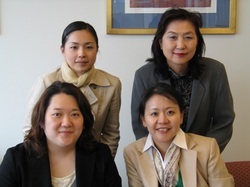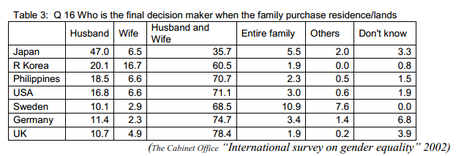
In the 1950's women were surveyed and asked if they had the chance to be reborn would they want to be a women and only 16.1 percent agreed, which is not a lot at all, by 1987 that percentage had doubled to about 53.7 (Nakamura,1996). The status of women in gradually improving not only in the workplace but also in the family and how society views them. Though, its improving faster in the household more than than the workplace and society. "A man's place is at work, while a woman's place is in the home," is starting to fade away. Now it seems like a woman's place is at work AND in the home. Women started working in factories which aren't the best and safest place to be working at. in the 1990's about 50 percent of females over the age of 15 were working in paid labor force. As you can see in the graph below more and more females are becoming managers, chiefs, and directors in the last 30 years.
The life expectancy also rose to about 82.98, while men are at about 76.57 in 1994(Nakamura,1996).. Also women are starting to have the freedom of not having to get married at such a young age anymore, the "proper" age to get married is starting to vanish in Japan, which also makes the number of women that are unmarried to increase(Lim Shan-Loong,NA). Getting married at such a young age isn't pushed on the women as much as it was lets say 20 or 30 years ago. About 40 percent of women in the 20's are not married.
The education rate for females is also rising, more and more females are found at four year universities and junior colleges(Lim Shan-Loong,2000). Though, for some reason the parents of females urge their daughters to go to junior colleges rather than a four year.(Nakamura,1996). Woman surpassed males on voting too, in about the 1990's is when this changed occurred. Females became more interested in politics right about after the the war, 40 percent of females said they "have an interest". and 60 percent don't, but those number reversed in the 1990's.
As you can see in the graphs below the statement "men at work and women at home", people are agreeing less and less with it as the years go on. In 1992 232 percent of people agreed with this but when it came to 2007 13.8 percent agreed with that statement, so you can see the change in the way people are thinking(Nakamura,1996). But as you can see in the other statement, "Who makes the final decision in the household" the husband seems to take charge of the decisions even though, people agree with the wife being at home, you would think they would have the household decisions, but clearly the husband takes the authority over the home still.
Nakamura M. (1996, Feb 26). The present status of women. Retrieved from http://www.gender.go.jp/english_contents/category/pub/whitepaper/plan2000/e01.html
Friedman , S. (1992). The changing roles of women in japan. Retrieved from http://www2.gol.com/users/friedman/writings/p1.html
Lim Shan-Loon, M. (2000, March 14). Gender roles in japan. Retrieved from http://marklsl.tripod.com/Writings/japan.htm
The life expectancy also rose to about 82.98, while men are at about 76.57 in 1994(Nakamura,1996).. Also women are starting to have the freedom of not having to get married at such a young age anymore, the "proper" age to get married is starting to vanish in Japan, which also makes the number of women that are unmarried to increase(Lim Shan-Loong,NA). Getting married at such a young age isn't pushed on the women as much as it was lets say 20 or 30 years ago. About 40 percent of women in the 20's are not married.
The education rate for females is also rising, more and more females are found at four year universities and junior colleges(Lim Shan-Loong,2000). Though, for some reason the parents of females urge their daughters to go to junior colleges rather than a four year.(Nakamura,1996). Woman surpassed males on voting too, in about the 1990's is when this changed occurred. Females became more interested in politics right about after the the war, 40 percent of females said they "have an interest". and 60 percent don't, but those number reversed in the 1990's.
As you can see in the graphs below the statement "men at work and women at home", people are agreeing less and less with it as the years go on. In 1992 232 percent of people agreed with this but when it came to 2007 13.8 percent agreed with that statement, so you can see the change in the way people are thinking(Nakamura,1996). But as you can see in the other statement, "Who makes the final decision in the household" the husband seems to take charge of the decisions even though, people agree with the wife being at home, you would think they would have the household decisions, but clearly the husband takes the authority over the home still.
Nakamura M. (1996, Feb 26). The present status of women. Retrieved from http://www.gender.go.jp/english_contents/category/pub/whitepaper/plan2000/e01.html
Friedman , S. (1992). The changing roles of women in japan. Retrieved from http://www2.gol.com/users/friedman/writings/p1.html
Lim Shan-Loon, M. (2000, March 14). Gender roles in japan. Retrieved from http://marklsl.tripod.com/Writings/japan.htm


 RSS Feed
RSS Feed